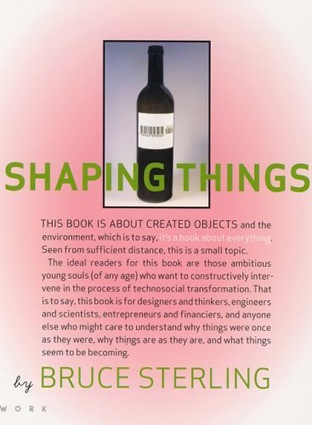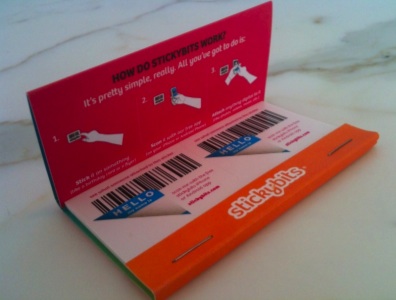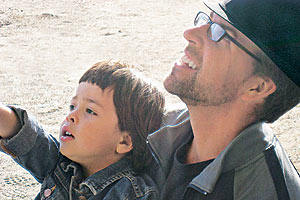Erik Hopp, the web dude who mainly built Shareable.net, loaned me a book that is taking over my mind. It’s called Shaping Things, by the science-fiction novelist Bruce Sterling, and it came out in 2005. Erik mentioned the book in a conversation about a brand new technology called Stickybits. Here’s how the blog Techcrunch describes Stickybits:
Every place and object in the world has a secret past: who lived there, who passed by, who touched it. The secret lives of objects are filled with such details. If only you could make them talk. But what if you could give any physical object a story simply by sticking a barcode on it and appending a message to that barcode? The message could be a photo, a text message, a video, or a voice note. All anyone would need to unlock the message is a phone with a special barcode scanning app.
Stickybits is that app. Founded by Billy Chasen (the original programmer behind Chartbeat) and Seth Goldstein (chairman and founder of SocialMedia), the startup just closed a $300,000 seed round from Polaris Venture Partners and Mitch Kapor. Officially launching this week at Austin’s SXSW festival, stickybits is a new mobile app for both the iPhone and Android. It lets you scan any barcode and attach a message to that physical object.
The barcode in a greeting card , for instance, could trigger a video message from the sender. One on a box of medical supplies could inventory what is inside. A business card with a code on it could link to a resume or LinkedIn profile. Museums and theme parks could use them for audio tours and maps. Local merchants could use the barcodes to track deliveries or place them in their storefront windows to distribute digital coupons and offers to passersby. The possibilities are endless.
Endless, indeed. The uses Techcrunch imagines seem trivial to me. What if Stickybits-type technologies were put to use to help us understand the environmental and social impact of every product we came across, and that information was required to be there, by law? What if the Stickbits tech were merged with augmented reality, so that we can just pass our iPhones or Androids over a product and see that social and environmental impact superimposed on the object? How would that change our sense of our own personal global positioning?
 What about the technology’s impact on social life? What if you could read an object’s ownership history at a glance, and ping that person instantaneously? What new kinds of community would arise from that new kind of social relationship? What if each object could tell its own audio/visual/textual/musical stories, stories that would be shared through time and space? It would be a new kind of marginalia…but might it also give rise to new kinds of art? Would we start seeing "sticky-artists" emerge, their talking, singing objects collected in museums and galleries?
What about the technology’s impact on social life? What if you could read an object’s ownership history at a glance, and ping that person instantaneously? What new kinds of community would arise from that new kind of social relationship? What if each object could tell its own audio/visual/textual/musical stories, stories that would be shared through time and space? It would be a new kind of marginalia…but might it also give rise to new kinds of art? Would we start seeing "sticky-artists" emerge, their talking, singing objects collected in museums and galleries?
Enter Bruce Sterling and Shaping Things, which predicts the development of Stickybits technology and explores its social implications. Sterling calls the technology "Spimes."
"I would date the dawn of Spimes to 2004, when the United States Department of Defense suddenly demanded that its thousands of suppliers attach Radio Frequency ID tags, or ‘arphids,’ to military supplies," writes Sterling.
The most important thing to know about Spimes is that they are precisely located in space and time. They have histories. They are recorded, tracked, inventoried, and always associated with a story.
Spimes have identities, they are protagonists of a documented process.
They are searchable, like Google. You can think of Spimes as being auto-Googling objects.
Cool, huh? But that’s only the beginning of what you need to know about Sterling’s Spime concept. Sterling speculates that Spimes will trigger the next technological "point of no return," where the devices become essential for human interaction with objects–and thus essential to our survival as a species. (Sound outlandish? Think about what would happen to our society, to you, if cars, trucks, and planes all suddenly stopped; think about what would happen, right now, if the entire Internet crashed.)
In other words, Spimes, if widely implemented, would take social sharing to the next level, and increase our global interdependence. New threats will emerge, to our privacy and freedom, and so will new countermeasures. The questions go deeper, when we ask what happens when machines and tools universally speak: Will Spimes revive animistic worldviews or give rise to some new collective intelligence?
"Machines are becoming more human," said the science-fiction novelist Philip K. Dick in 1972. "Our environment, and I mean our man-made world of machines — is becoming alive in ways specifically and fundamentally analogous to ourselves." In these ways, as our environments come to life, they become a mirror, and a battlefield.










